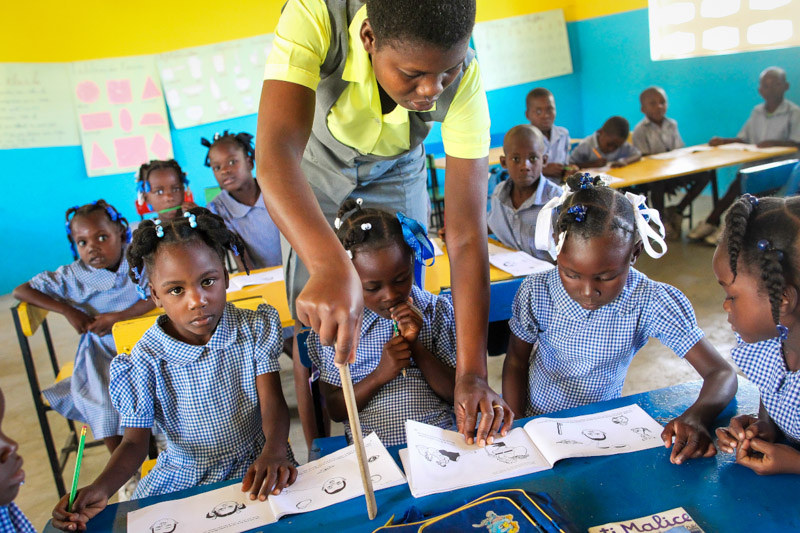The 16%: Reaching a Tipping Point in Education Systems
Image credit: https://hiveminer.com/Tags/haiti%2Cteacher/Interesting
“A bad doctor can kill a patient; a bad teacher can kill an entire generation” [1]
A country’s education system is intrinsically linked to its economic growth and standard of living [2]. A country with an effective education system has better doctors, lawyers, engineers and inventors. A population that is well educated is more politically engaged and likely to have a more accountable government. An educated workforce attracts more businesses from abroad and creates new businesses of their own. The quality of education in a country directly affects the economic, societal and physical wellbeing of everyone in it.
This understanding has largely driven a global effort to ensure that every child in the world attends primary school. This effort has been largely successful — we have seen the number of children attending school rise dramatically around the world. But sitting in a classroom is not the same thing as receiving an education. This is especially true in developing countries where the quality of education is abysmally low. Studies of low-income countries show that a large portion of students who complete primary school lack basic reading, writing and arithmetic skills, in what is called the global learning crisis [3]. In Haiti, nearly 80% of teachers have not received any pre-service training, and 75% of students cannot read a single word after completing first grade [4]. This is not only bad for students, this is detrimental to the future development of their countries.
While it is vital to improve the quality of education in Haiti and around the world, it takes a substantial amount of time and effort to increase educational outcomes for each teacher. Ensuring that every student receives a quality education is too important for a slow-moving approach. In the time that it would take to sufficiently train every teacher, entire generations would be left behind and economic development would be stifled for decades to come.
How can we impact the millions of educators around the world that desperately need training? What if there was a way to influence the quality of education without having to train every teacher individually? If we treat high quality education as an innovation, perhaps we can influence not just individual educators, but the system as a whole.
The Diffusion of Innovations theory describes how an innovation spreads throughout a social system [5]. This theory proposes that different groups of individuals adopt innovations at different times, and that those who adopt them early on influence the adoption of others. When a certain percentage of people adopt an innovation, it reaches a tipping point and begins to spread throughout the system. Figure 1 shows how the different groups adopt an innovation over time. When a new innovation is introduced into society — say a new smartphone — the first two groups (16% of the system) are the ones who rush out and buy it. As they use their new phones, show them to their friends, and talk about them on social media, the next group (up to 50%) decides that they want to give this product a shot as well. Eventually, those who have not yet adopted this new phone (the remaining 50%) decide that it must work well if everyone else is using it, and the innovation makes its way throughout the rest of the system.
Figure 1
This understanding shows that influencing a system does not require reaching each person individually. As the first 16% begin to use the new innovation, the remaining groups are influenced to do so as well. This could mean that transforming a country’s education system doesn’t require training 100% of its teachers. If we instead treat good education techniques as an innovation, reaching just 16% of teachers could lead to those techniques being adopted throughout the entire system. In Haiti, reaching the tipping point would only require providing training to 2,880 schools.
This notion, if correct, could be transformative. The main approach to teacher training in the developing world has long prioritized reaching as many educators as possible. While this approach is well intentioned, it has largely proven ineffective [6]. By spreading resources thin, teachers don’t get the in-depth, personalized training that they need. Meanwhile, there has been a recent wave of interest in small-scale, personalized teacher training programs in developing countries that have shown promising results [7]. In 2018, we launched our own In-School Professional Development program, and have seen large impacts. But critics of these trainings argue that they are too expensive, time consuming, and won’t be able to reach enough students.
If we view education as a connected system, emphasizing quality over quantity may be exactly the right approach. Rather than attempting to simply ‘reach’ every educator, we can focus our effort and resources on dramatically improving the quality of education for the initial 16%. As these educators incorporate new and innovative practices into their classrooms, their students will have higher educational outcomes and other teachers, schools and organizations will take notice. In the same way that a new smartphone spreads throughout society, so will educational practices that transform entire countries.
[1] An educator at a P4H Global training said this to me in 2015
[2] https://en.wikipedia.org/wiki/Endogenous_growth_theory
[3] http://blogs.worldbank.org/education/teach-tackling-learning-crisis-one-classroom-time
[4] https://www.usaid.gov/sites/default/files/documents/1862/FINAL_EducationMarch2017.pdf
[6] http://documents.worldbank.org/curated/en/349051535637296801/pdf/WPS8572.pdf


